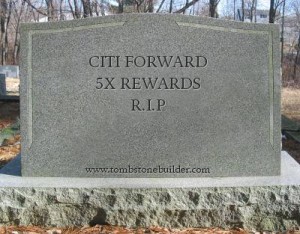Are you ready for an extra-ghoulish, super-frightening summary of what’s new in the financial world?
A FRIGHTENING THOUGHT–5X OPTIONS DISAPPEARING: Imagine, if you will, a world in which it was impossible to earn 5X rewards on credit card purchases. I think it’s safe to say that the survivors would envy the dead in such a scenario. But that may be the direction we’re moving in, as the Citi Forward is no longer offering 5X ThankYou Points on restaurants and bookstores.
A moment of silence, please…
HOW MUCH ARE YOUR BODY PARTS WORTH?: Bloomberg knows. There’s money in them there kidneys!
HERE’S A SCARY FINANCIAL PICTURE: Investor credit seems to be peaking. Look out below?

HAUNTED REAL ESTATE: The Zillow blog has the story about what it’s like to live in a haunted house. Those looking for a bargain may find haunted houses to be a good value. According to a survey from realtor.com:
- 26 percent indicated they would consider purchasing a haunted house for sale
- 36 percent might consider a haunted home purchase
- 38 percent would not consider a haunted home purchase
What would it take to get somebody to pull the trigger on a haunted house?
- 12 percent would pay full market value or more for a haunted house for sale
- 34 percent would purchase a haunted home if it were discounted 1 to 30 percent
- 22 percent would purchase a haunted home if it were discounted 31 to 50 percent
- 19 percent would purchase a haunted home if it were discounted 51 percent or more
A SCARY CONSPIRACY: What’s scarier than a price-fixing cartel? How about a cartel that’s doing so legally right here in the U.S.:
On the last week of April earlier this year, a small committee of doctors met quietly in a midsized ballroom at the Renaissance Hotel in Chicago. There was an anesthesiologist, an ophthalmologist, a radiologist, and so on—thirty-one in all, each representing their own medical specialty society, each a heavy hitter in his or her own field.
The meeting was convened, as always, by the American Medical Association. Since 1992, the AMA has summoned this same committee three times a year. It’s called the Specialty Society Relative Value Scale Update Committee (or RUC, pronounced “ruck”), and it’s probably one of the most powerful committees in America that you’ve never heard of.
The purpose of each of these triannual RUC meetings is always the same: it’s the committee members’ job to decide what Medicare should pay them and their colleagues for the medical procedures they perform. How much should radiologists get for administering an MRI? How much should cardiologists be paid for inserting a heart stent?
While these doctors always discuss the “value” of each procedure in terms of the amount of time, work, and overhead required of them to perform it, the implication of that “value” is not lost on anyone in the room: they are, essentially, haggling over what their own salaries should be. “No one ever says the word ‘price,’ ” a doctor on the committee told me after the April meeting. “But yeah, everyone knows we’re talking about money.”
There’s more:
That doctor spoke to me on condition of anonymity in part because all the committee members, as well as more than a hundred or so of their advisers and consultants, are required before each meeting to sign what was described to me as a “draconian” nondisclosure agreement. They are not allowed to talk about the specifics of what is discussed, and they are not allowed to remove any of the literature handed out behind those double doors. Neither the minutes nor the surveys they use to arrive at their decisions are ever published, and the meetings, which last about five days each time, are always closed to both the public and the press. After that meeting in April, there was not so much as a single headline, not in any major newspaper, not even on the wonkiest of the TV shows, announcing that it had taken place at all.
In a free market society, there’s a name for this kind of thing—for when a roomful of professionals from the same trade meet behind closed doors to agree on how much their services should be worth. It’s called price-fixing. And in any other industry, it’s illegal—grounds for a federal investigation into antitrust abuse, at the least.
But this, dear readers, is not any other industry. This is the health care industry, and here, this kind of “price-fixing” is not only perfectly legal, it’s sanctioned by the U.S. government.
Now that is scary!

On the last point, I’d normally agree with something like that being price fixing, but being a son of two doctors, I can tell you this is nothing compared to the crap that medicare unleashes on them constantly, cutting payouts on anything and everything, decided by suits in Washington and not by actual market forces.
Unfortunately, medicine is not part of the free market because the end users don’t have much choice, and doctors don’t really “set” their prices in a conventional sense. Medicare just tells them what they’ll be paid on each procedure and all other insurance companies more or less peg their payouts to that. Imagine working a job where one day you’re told what you do will make you half and there’s nothing you can do. There’s no equivalent to switching employers in medicine.
Thanks for the feedback! Based on what I’ve read, it seems that doctors are really getting squeezed right now.